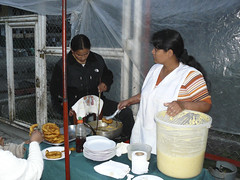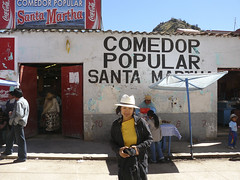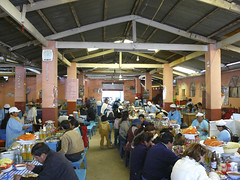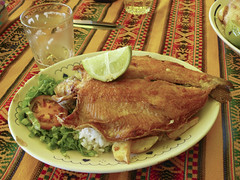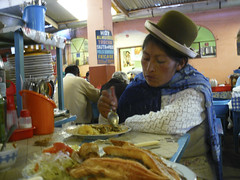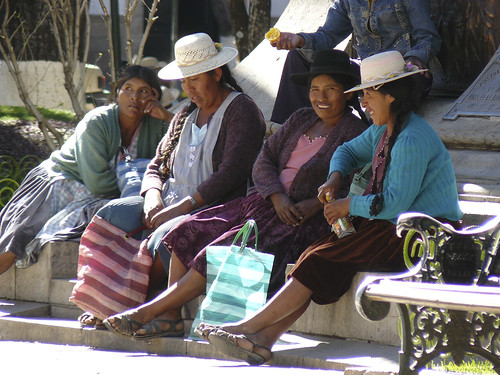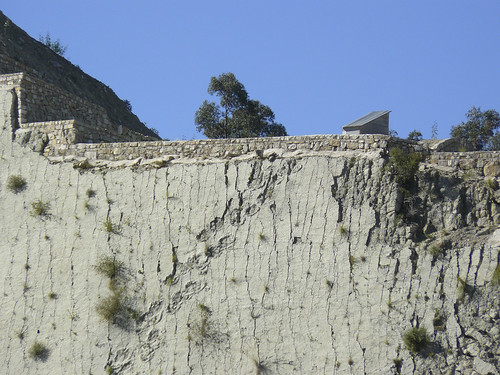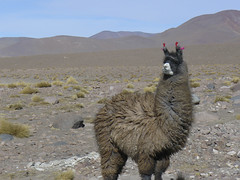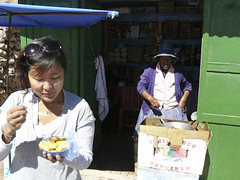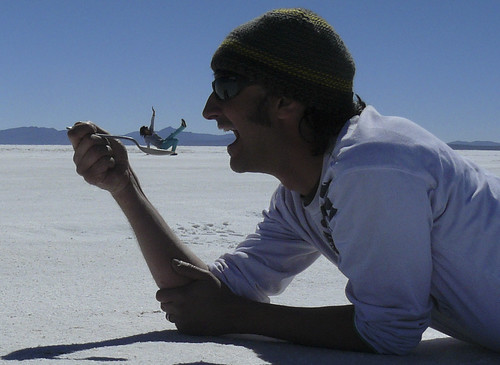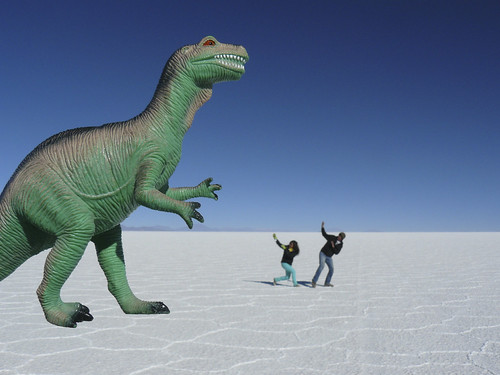There’s no better afternoon snack than picarones– fried donuts with a little bit of anise, covered with molasses–made right on the spot.
little doughy goodness…
May 31st, 2008Machu Picchu
May 31st, 2008 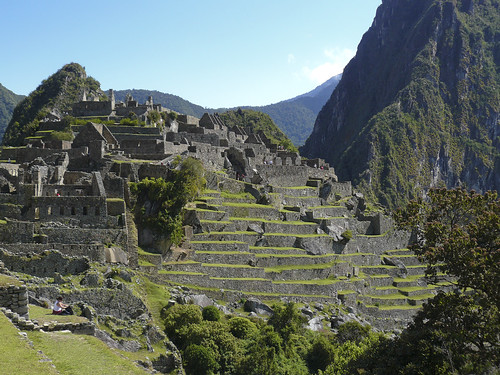
Ten years ago, I traveled with my friend Kelly to Aguas Calientes to visit Machu Picchu. Back then, it was still the road less traveled with few tourist and even fewer places to sleep. In fact, that might have been my first ¨hostel¨experience, only I don´t think they called it a hostel/hospedaje then. At that time, there were only two places to stay in Aguas Calientes, our choice was either the nice hotel or the other place. We picked the other place, which proved to be a bad move. These days, the small town of Aguas Calientes is home to many restaurants, hostels and hotels, completely over-run by tourists heading to Machu Picchu.
Mike and I woke up bright an early and were at Machu Picchu by 6:30am to catch the sunrise.
fancy a hat??
May 26th, 2008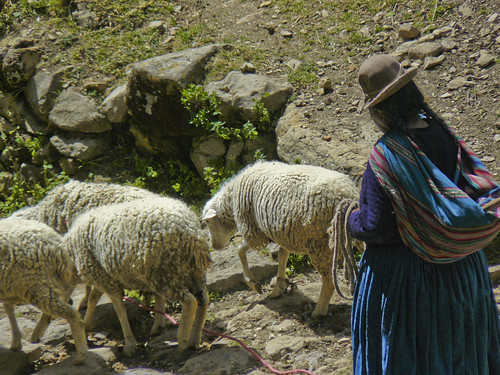
One of the things I like about Bolivia is that the women love to wear hats. It doesn’t necessarily have a purpose, like to shield them from the sun, but their hat is necessary to finish off their “look,” and to me that is the perfect definition of an accessory–I love it.
Actually if you go back in time, the different tribal groups in Bolivia could be identified, not only though their textiles patterns, but also from the style of hat worn. But as recently as 1920, it is believed a shipment of bowler hats was sent from Europe, meant for the Europeans working on the railroad in Bolivia. These hats, too small for the European men, were quickly adopted by the Aymara and Quechua women of Bolivia.
The hat is so out of place that it works with the traditional Bolivian garments. The women wear tiered velveteen skirts with petiticoats underneath. The skirts are typically brightly colored in violets, reds, tangerines, and inky colors. In the south it seemed the perfered length is at the knee, worn with knee-hi socks, but further north, it’s longer, and worn with a hand -crochet cardigan. Also, every Bolivian woman must have a tapestry wrapped around her shoulders either carrying a grandchild or some other bundle on her back. Whether the skirt length is long or short, the bowler hat works for any occasion, even tending the sheep.
“Hay trucha!” (there’s trout!)
May 26th, 2008The local people who live on Lake Titicaca are pretty much all farmers–either terrace farmers on the land or they are farmers on the lake. Well, some of the people still actually fish, but much of the trout is now farm raised in small cages on the lake. Trout is on every menu of every restaurant in town, and it can be prepared one of 8 different ways. We stuck with the pan fried version with lime, rice and fries–so delicious for only 18 Bolivianos ($2.47), we ate it nearly every meal.
“I’m off to my vacation at Lake Titicaca. Try to make a joke out of that, Mr. Smart Guy.”
May 24th, 2008Sucre
May 24th, 2008We spent a few days in Sucre trying to recover from the previous week’s travel. Sucre is a cute little city with a nice main square, where there’s always people hanging out. While in the square, there is no way to avoid having a homemade ice cream, which can be had for a whopping 1 Boliviano, or about 13 cents, and that’s including sprinkles! We basically hung out in the city for a few days only venturing out a bit to see some dinosaur footprints that were found accidentally in a quarry just outside of town.
A tale of two buses
May 24th, 2008 Before Bolivia, our experiences with buses in South America has been pretty good. Sure, spending 15-20 hours on a bus isn’t ideal, but the buses in Brazil and Argentina are really something else. Take a look. It’s a luxury liner. You get meals, drinks, movies, a bathroom and a steward on board. Compared to the Chinatown bus to New York, these buses are like riding on the space shuttle. Check out this animation below, demonstrating all of the seat choices. Premium class turns into a bed. Pretty sweet.
Before Bolivia, our experiences with buses in South America has been pretty good. Sure, spending 15-20 hours on a bus isn’t ideal, but the buses in Brazil and Argentina are really something else. Take a look. It’s a luxury liner. You get meals, drinks, movies, a bathroom and a steward on board. Compared to the Chinatown bus to New York, these buses are like riding on the space shuttle. Check out this animation below, demonstrating all of the seat choices. Premium class turns into a bed. Pretty sweet.
[kml_flashembed movie=”https://www.yobosayo.net/wp-content/uploads/2008/05/clasico.swf” height=”230″ width=”570″ /]
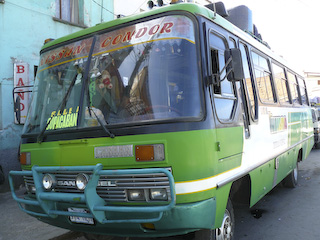 Now this is a bus in Bolivia. Study the photo intently and you may notice a few differences. There’s no need for an animation depicting the various seat choices because there are no choices. In fact, you don’t even need a seat. They will sell you standing room…on a 10 hour overnight trip! Our ride from Uyuni to Sucre had 40 seats, and 55 passengers. People standing and sleeping in the aisles, sitting on each other’s laps…the only thing missing was livestock. Somehow we managed to get a few hours of sleep despite the bumpy ride. (only 5% of roads in Bolivia are paved)
Now this is a bus in Bolivia. Study the photo intently and you may notice a few differences. There’s no need for an animation depicting the various seat choices because there are no choices. In fact, you don’t even need a seat. They will sell you standing room…on a 10 hour overnight trip! Our ride from Uyuni to Sucre had 40 seats, and 55 passengers. People standing and sleeping in the aisles, sitting on each other’s laps…the only thing missing was livestock. Somehow we managed to get a few hours of sleep despite the bumpy ride. (only 5% of roads in Bolivia are paved)
Salar de Uyuni Panorama
May 24th, 2008Zamfir would be proud
May 23rd, 2008[youtube]http://www.youtube.com/watch?v=RpvBnaQrF6U[/youtube]
The 5°F dance
May 23rd, 2008[youtube]http://www.youtube.com/watch?v=GN6VugtKyxQ[/youtube]
eating llama
May 22nd, 2008When food is scarce we have to take extreme measures
May 22nd, 2008Unexpected wildlife sighting in the Salar de Uyuni
May 22nd, 2008Salar de Uyuni
May 22nd, 2008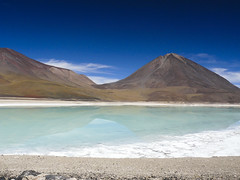 We joined a tour in San Pedro de Atacama in Chile. The tour took us from the Bolivian border in the south, driving though the desert and salt flats and terminating in Uyuni. The highlight is the visit to the Salar de Uyuni, the largest salt flats in the world. There is an estimated 10 billion tons of salt on the 1048 square miles that make up the salt flats. The trip is only about 180 miles in total, but it takes 3 days to get to the salt flats. It requires a bit of hardship, and there’s no avoiding it (when traveling south to north). On days 1 and 2 we mostly visited various lagoons– the green, red, white lagoons, as well as a thermal hot springs, and the morning sun geyser basin. The scenery was picturesque and beautiful, but the driving through the desert, slow and dusty.
We joined a tour in San Pedro de Atacama in Chile. The tour took us from the Bolivian border in the south, driving though the desert and salt flats and terminating in Uyuni. The highlight is the visit to the Salar de Uyuni, the largest salt flats in the world. There is an estimated 10 billion tons of salt on the 1048 square miles that make up the salt flats. The trip is only about 180 miles in total, but it takes 3 days to get to the salt flats. It requires a bit of hardship, and there’s no avoiding it (when traveling south to north). On days 1 and 2 we mostly visited various lagoons– the green, red, white lagoons, as well as a thermal hot springs, and the morning sun geyser basin. The scenery was picturesque and beautiful, but the driving through the desert, slow and dusty.
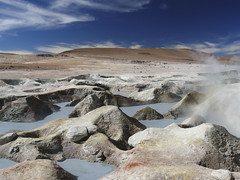 Dealing with the altitude was difficult. At our highest we were at 4270 meters. Shortness of breath, dehydration and headache occurs, along with the continued need to pee. The high altitude also means that temperatures vary greatly. It can be cold and windy even with the sun out, making it necessary to be bundled up. My daytime outfit: a jacket, sweater, hoody, long sleeve tee, short sleeved tee, camisole, leggings, jeans, two pairs of socks, hat and gloves. If the wind dies down, it’s possible to strip down to a long sleeved top.
Dealing with the altitude was difficult. At our highest we were at 4270 meters. Shortness of breath, dehydration and headache occurs, along with the continued need to pee. The high altitude also means that temperatures vary greatly. It can be cold and windy even with the sun out, making it necessary to be bundled up. My daytime outfit: a jacket, sweater, hoody, long sleeve tee, short sleeved tee, camisole, leggings, jeans, two pairs of socks, hat and gloves. If the wind dies down, it’s possible to strip down to a long sleeved top.
Our first night, the11 of us on the tour were split into 2 dorm rooms–which in itself was not my favorite–to sleep with 6 strangers in the same room. But the real issue was dealing with no heat in the rooms and having bathrooms outside. The temperature was around about 5’F outside. Inside, Mike and I squeezed into a single bed hoping for shared body heat. With 5 heavy blankets, a sleeping bag each, and my daytime outfit, I was just about right. Our second night, we stayed in hotel made of salt. We had a private room and bath with hot water. It was not nearly as cold as the first night, even without heat.
 The third morning we woke at 5am to catch the sunrise on the Uyuni Salt Flats. This was beautiful. With the first light of the sun reflecting off the hexagon-like pattern of the salt flats, it was just incredible. Once the sun was up, it was impossible to look onto the salt flats without sunglasses.
The third morning we woke at 5am to catch the sunrise on the Uyuni Salt Flats. This was beautiful. With the first light of the sun reflecting off the hexagon-like pattern of the salt flats, it was just incredible. Once the sun was up, it was impossible to look onto the salt flats without sunglasses.
sights around San Pedro de Atacama
May 20th, 2008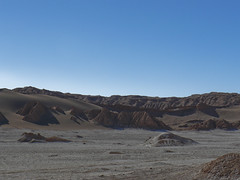 Only 16km from San Pedro de Atacama, the Valle de la Luna (or Moon Valley) is named appropriately so, due to the strong resemblance to the surface of the moon. Much of the dramatic landscape has been created over time from erosion. There are sand dunes, surfaces that look similar to Cappadocia in Turkey, and interesting salt/dirt caves.
Only 16km from San Pedro de Atacama, the Valle de la Luna (or Moon Valley) is named appropriately so, due to the strong resemblance to the surface of the moon. Much of the dramatic landscape has been created over time from erosion. There are sand dunes, surfaces that look similar to Cappadocia in Turkey, and interesting salt/dirt caves.
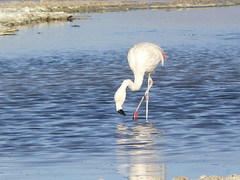 We also stopped at Laguna Chaxa, where the surface of the dry land is composed of salt crusts, and flamingos feed in the salt lakes.
We also stopped at Laguna Chaxa, where the surface of the dry land is composed of salt crusts, and flamingos feed in the salt lakes.
Santiago to Calama in the north
May 20th, 2008From Santiago we took a 22 hour bus to Calama. The trip should have been 20 hours, but the bus broke down adding another 2 hours to our already long ride. The Bolivian Consulate in Santiago ran out of visas (the actual sticker that goes into the passport), so we headed up to Calama to get our visa. Obtaining the visa turned out to be a pain, and we later learned that you can bypass the system by booking a Uyuni tour, and the tour operators will get you the visa at the border. I wish we knew that before we went through all the trouble.
seafood in Chile
May 20th, 2008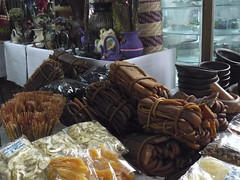 I wish we had more time in Chile to eat…Chileans love seafood. It’s no wonder as the country is basically all coastline. Mussels, crab and fish are on most menus. Congrio, a white fish similar to kingclip (or cod), is national favorite prepared a number of different ways. The stew version is delicious–onions, tomatoes, potatoes. The other ingredient that is commonly found in Chilean cuisine is algae or seaweed. This is mostly used in soups and salads. When I first saw these dried bundles of algae at the market, I thought it was raw hide.
I wish we had more time in Chile to eat…Chileans love seafood. It’s no wonder as the country is basically all coastline. Mussels, crab and fish are on most menus. Congrio, a white fish similar to kingclip (or cod), is national favorite prepared a number of different ways. The stew version is delicious–onions, tomatoes, potatoes. The other ingredient that is commonly found in Chilean cuisine is algae or seaweed. This is mostly used in soups and salads. When I first saw these dried bundles of algae at the market, I thought it was raw hide.
Valparaiso, Chile
May 18th, 2008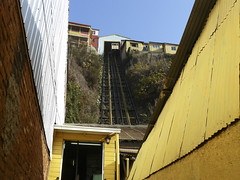 Valparaiso, located on the coastline of Chile, is not more then 1.5 hours by bus from Santiago. An old port city built on the edge of the water with hills running right into the ocean. The city has 15 funiculars, which were built between 1883-1914, and are still in use today. Costing anywhere from 100 to 250 pesos per ride (22 to 53 cents), it’s a steal if you don’t feel like walking up one of the 42 steep hills of Valparaiso.
Valparaiso, located on the coastline of Chile, is not more then 1.5 hours by bus from Santiago. An old port city built on the edge of the water with hills running right into the ocean. The city has 15 funiculars, which were built between 1883-1914, and are still in use today. Costing anywhere from 100 to 250 pesos per ride (22 to 53 cents), it’s a steal if you don’t feel like walking up one of the 42 steep hills of Valparaiso.
Small independent boutiques and cafés add charm to the city, along with graffiti that is ever present. Also interesting are the houses are mostly all paneled in corregated metal and brightly painted.
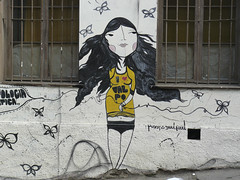 Valparaiso is an easy town to navigate and explore day and night. Saturday we stopped at Cinzano for lunch at 4pm and listened to an old time guitarist play traditional folk songs. In the evening we went out for a nice dinner at 10pm, then out to a club until 2:30am. It was a late night for us, but for Chileanos it was just starting to get going.
Valparaiso is an easy town to navigate and explore day and night. Saturday we stopped at Cinzano for lunch at 4pm and listened to an old time guitarist play traditional folk songs. In the evening we went out for a nice dinner at 10pm, then out to a club until 2:30am. It was a late night for us, but for Chileanos it was just starting to get going.
Blown Away in Torres del Paine
May 18th, 2008[youtube]http://www.youtube.com/watch?v=PqAwziT1jd8[/youtube]
